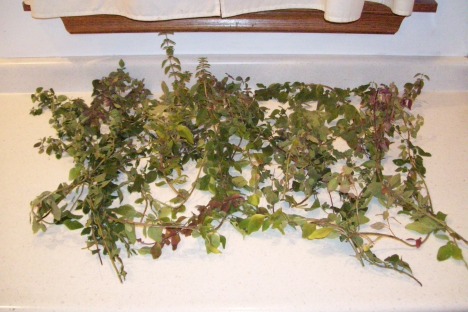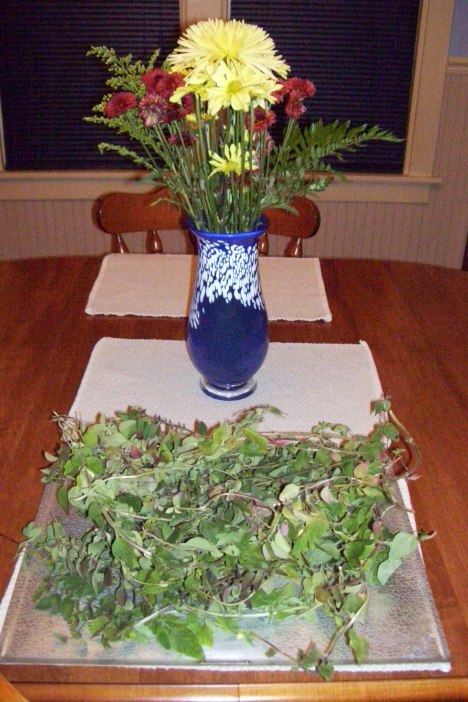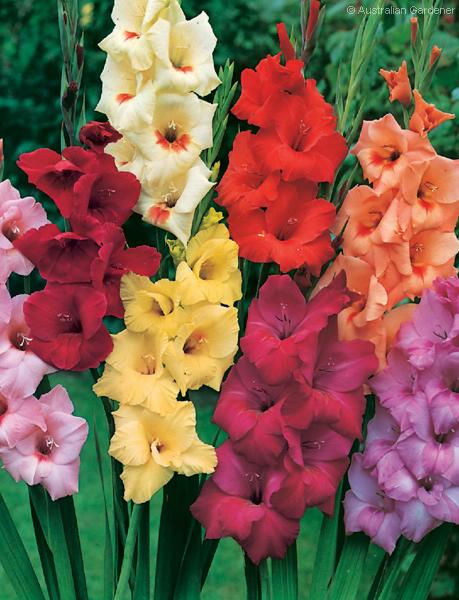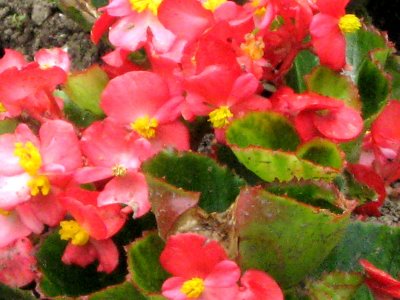Every now and then the Chicago Tribune reminds me that it’s still a great newspaper. It doesn’t happen often anymore — the talent level has dropped dramatically from the glory days — but occasionally I’ll run across an article so well written, so thoughtful, so obviously made of love for the languages of communication, that I think, “Well, the Trib’s still got it a little.” Today is one of those times; read the whole thing by Barbara Mahany here.
It’s about gardening. Years ago a woman and her husband went looking to buy a townhouse so they wouldn’t have any yard to deal with. They ended up with a house in the suburbs instead, with a yard that was a mess. She ignored it until one day, after her children were born, she took a notion to try and straighten up a little. Once she got started, she couldn’t stop. Now she’s a master gardener.
I do want you to read the whole piece, but I’m going to quote and comment on some of her tips. I found them helpful; maybe you will too.
Here are her sure-fire suggestions for the finest garden you can fit in any size plot:
Mulch, mulch and more mulch. Becker has 5 cubic yards of organic leaf mulch dumped on her driveway every spring. She hauls it by the wheelbarrow to every breathing inch of her garden. It’s all about amending.
Who says Chicago’s growing season is too short?: Extend your season, says Becker, whose beds are in bloom from March to November, beginning with thousands of bulbs in early spring. (“Pick any area you can see from the house, not next to house,” she advises, to provide an emotional pickup after the long dark winter.) Then wind up with the last of the asters, fall-blooming crocus and a host of colorful berries.
There are two ideas here really, and I want to separate out the one that struck me the hardest: Don’t just make beds next to the house; plant in the yard so you can see your flowers from inside.
When I bought my house, one of the things I liked best was that the entire perimeter of the building had already been made into beds. There were bushes in front and along the sides, most of them planted decades ago, perhaps by the original owner. But there weren’t many flowers, just a few crocuses here and there. Aha, I thought; I will put in flowers, and over the years I have, tulips from Amsterdam as well as Holland, Michigan; irises, mums, petunias, marigolds, pansies, peonies, whatever I could get my hands on. I didn’t have a plan; I didn’t know what I was doing, but I enjoyed myself. Spring planting is my favorite time of year.
I screwed in hooks on the ceiling of my covered side porch and hung baskets of impatiens; I learned over time not to buy plastic pots. I turned my porch into an outdoor room, with a tree and plant stands, table and chairs, lights and a charcoal grill. Everyone who’s ever visited knows I love that porch.
But when I look out my front windows I don’t see flowers, except for my cherry trees when they blossom; otherwise it’s just green trees and green grass. I have to go outside to see my flowers, and I don’t do that often.
What Ms. Becker is teaching me is to plant colors I can see when I wake up in the morning. My first thought is to dig up some of the grass along the sidewalk leading to my front door and plant tulips and daffodils there; when they start to fade, I can put in begonias. (I have begonias in planters on the back deck, and oh, are they gorgeous this year.)
Then I thought, however nice that idea might be, why not create a similar path along the public right of way, the sidewalk that crosses my lot? What would a person walking up the street feel if she suddenly encountered flowers at her feet? Wouldn’t that be a joy?
My dog Luke and I take walks every night, and one of the things I get out of it is seeing my neighbors’ landscaping. Last night we took a new route on less-familiar blocks and I saw the most amazing stand of zinnias (I think); multiple colors planted in bunches, 50 yellows, then 50 reds, a whole rainbow, 20 feet or more. When Luke and I walk and I find beautiful flowers in yards, I always want to get closer to see and maybe smell; but I respect the homeowner’s private property, so I have to enjoy from a distance. Last night at this particular house on 2nd Street, a woman was watching TV in her living room, with the windows open; I wanted to call out, “Your flowers are beautiful!” But I turned shy instead.
People in my hometown are pretty good gardeners and landscapers. I’m envious, in awe; I wish I encountered people in their yards more often so I could tell them how much I love what they’ve done. But alas, Luke and I take our walks in the cool of the evening, and by that time most people are indoors watching the boob tube.
It’s fashionable lately when pseudo-sophisticates write about landscape gardening to decry the “airport runway” look with outdoor lights; but they’re just snobs with deadlines and 750 words overdue. These are the same kinds of people as those who write about food trends, invariably nasty, stuff you’d never want to eat — because they have to write about something and they’re totally completely bored. The New York Times is full of that crap, because New Yorkers can’t stop competing long enough to have a good meal. Here’s my point: anything you do, including landscape lights down the sidewalk, that you can see from indoors, is good. A flowered walk is a great idea, especially one built with the neighbors in mind.
I have a friend Chris who used to walk her little dog past my house all the time. Her husband’s since had a privacy fence built, and Chris and her dog have stopped coming by; I miss them. But if they had a sidewalk landscaped just for them to enjoy, I bet they’d always come this way; wouldn’t you?
My next-door neighbor Debbie has built an amazing garden spot on the corner; it’s got a boulder or two, figurines and wonderful plants. But there’s no reason I can’t do more with my space, even though I’m not on the corner. Some homeowners in town have built flowered areas under their hardwood trees, full of hostas or impatiens or other beauties. It takes time and money, but I think I’d like to do something similar.
And all this is suggested by Janice Becker’s little comment. Here’s more of what she told the Trib.
Sun, yes, but water moreso. Sure, you need to pay attention to shade versus sun, but drainage is too often overlooked. Becker contends it’s more important than sun, and she urges you to pay attention to what the label says — and take it to heart. “The label might say, ‘Will survive dry conditions,’ but what they really are saying is ‘We won’t tolerate standing in water.’ And with so much clay in the soil around here, that’s key.”
I don’t have clay in my yard; that’s Chicago, this is Northwest Indiana, a long-drained swamp. I’ve got 99% black loam from the last time the Iroquois River flooded five miles away. This is the richest soil on earth, according to Purdue University. We’re even the home of the high school soil-judging National Champions 2005!
Shop nonstop.”Don’t stop shopping for plants or planting just because it is July and abysmally hot. If succession of bloom is the objective (and it is), you will miss some great late summer and fall blooming perennials if you don’t frequent the nurseries. For example, chelone (also known as turtlehead) is an absolutely great late summer bloomer that you will never see unless you shop later in the season. And everything is usually on sale then.”
Be ever on the lookout. “Visit gardens all the time. There is practically nothing in my garden that I did not see someplace else and copy. Take notes; take pictures; and ask questions, particularly why that plant is growing successfully here when you haven’t had any success with it.”
That’s good advice too. Don’t get so enthusiastic with spring planting that you fail to keep at it when the weather gets hot, or much of your work will go for nothing. I weed and tend my gardens every day, pick tomatoes and peppers, strawberries and leeks. As Jamie says in The Centurion’s Boy, my novel in progress, “Every day is a new opportunity to excel.”
That’s true whatever your occupation, pastimes and pursuits. Every day is new; no matter how much you screwed up yesterday, today is a new opportunity. Maybe you don’t like digging in the dirt; maybe music or art or furniture-making is your thing. Do it better than ever, because it’s today. Whether you’re a stay-at-home mom or a CEO, a monk in Mississippi or a gardener in Deerfield, today is a new chance. Build something; touch your loved ones gently; take your dog on an outing. Write, cook, plan, build, take a risk, pull out the deadwood, get dirty so you can get clean; let yourself be fully alive.
And who knows, maybe once you get started, you won’t be able to stop.++
Filed under: cooking, environment, gardening, Luke, My dog, Purdue | Tagged: gardening | Leave a comment »


























